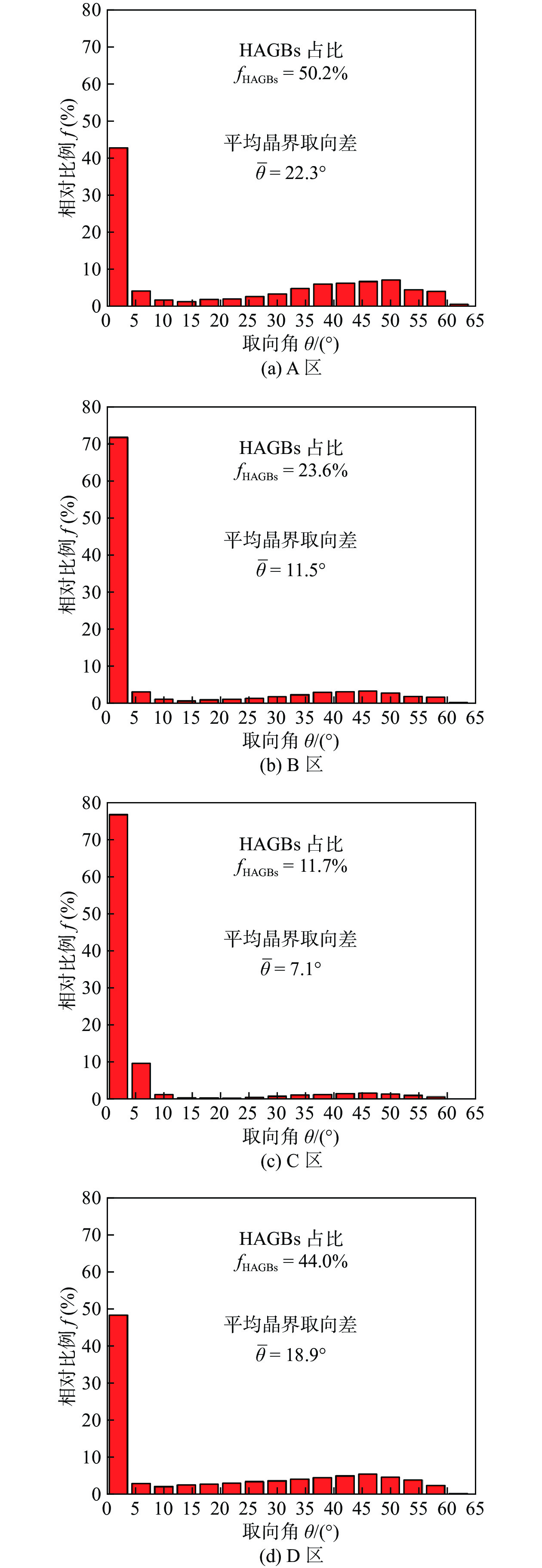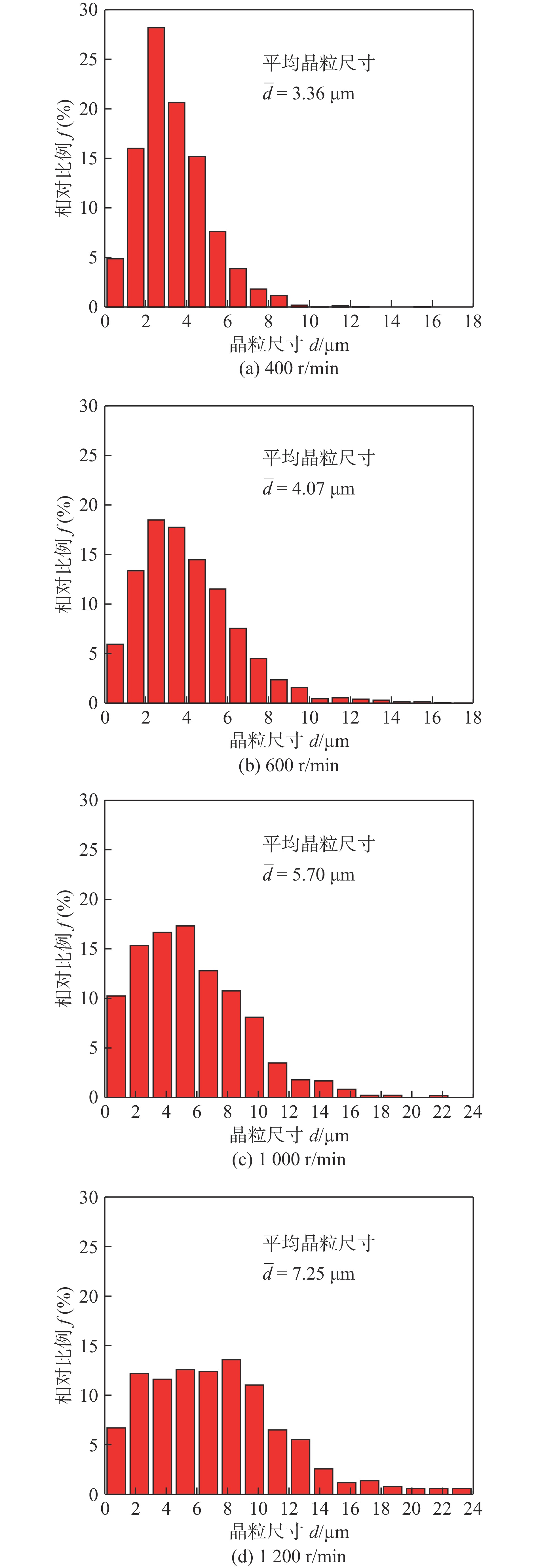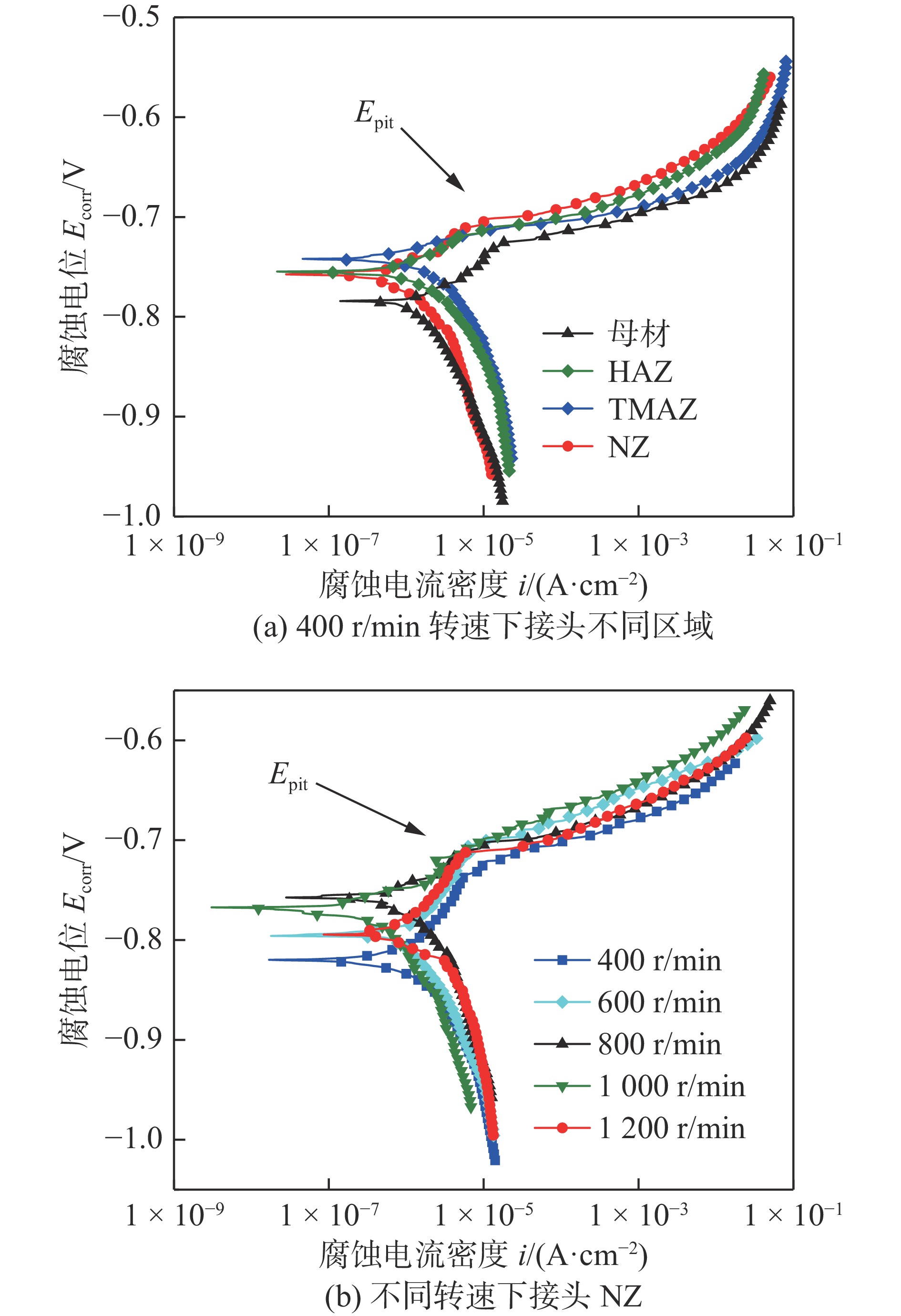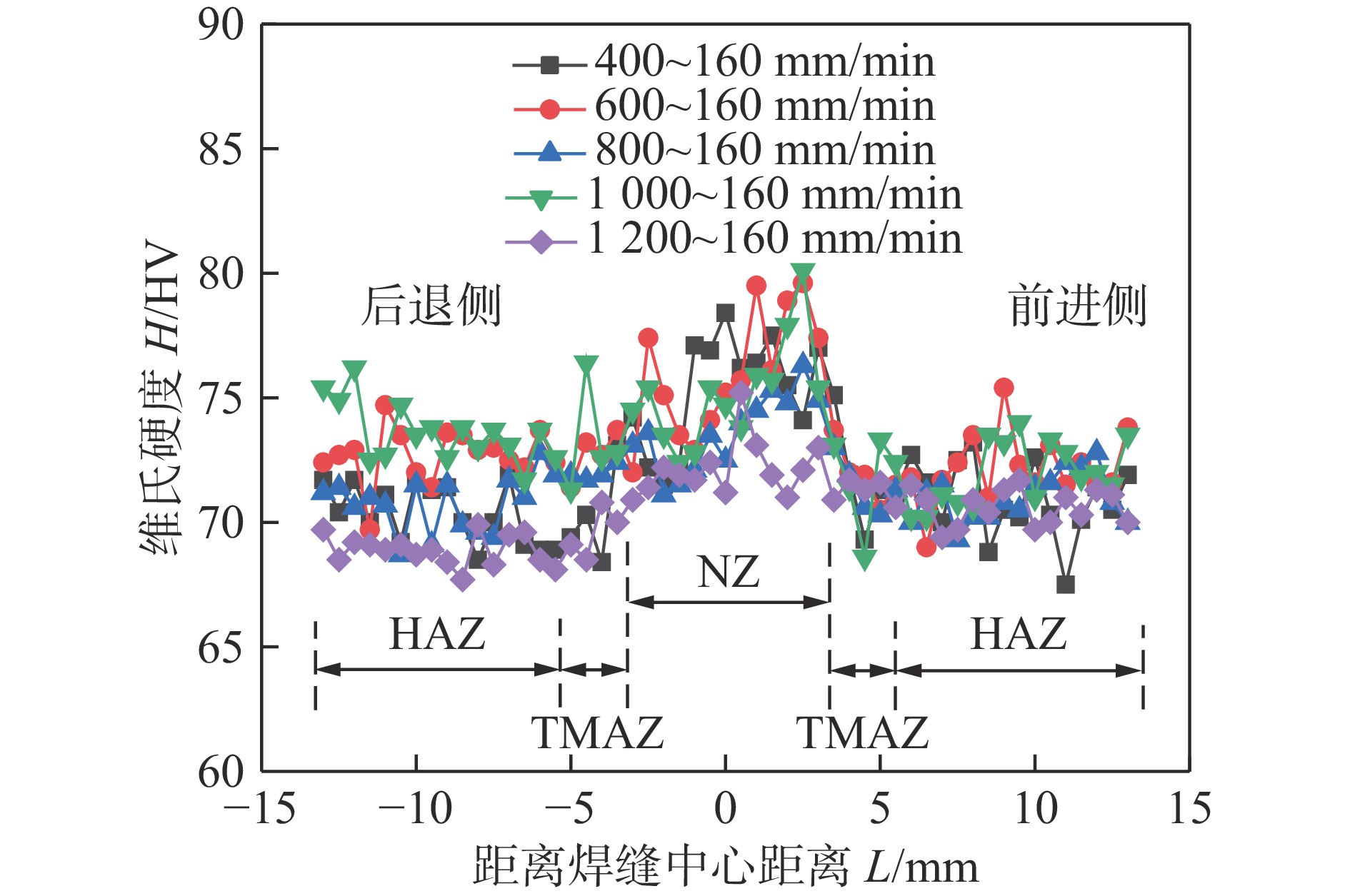Heat treatment tailoring of microstructure and properties of laser cladding carbide reinforced nickel based coatings
-
摘要:
基于激光熔覆技术成形了Ni35-WC-MoS2-CeO2自润滑耐磨涂层,研究了热处理对涂层的物相组成、显微组织、显微硬度、残余应力以及摩擦磨损性能的影响,揭示了涂层的磨损机理. 结果表明,激光熔覆层质量良好,没有出现明显气孔和裂纹,涂层与基体呈致密的冶金结合. 物相组成主要包括γ-(Fe, Ni),Cr7C3,M7C3以及MoS2和CrS两种润滑相等,显微组织主要为柱状晶和等轴晶,在基体中包含了块状硬质相和球形润滑相,平均显微硬度为904 HV,表面残余拉应力为304.6 MPa. 涂层的摩擦系数和磨损率分别为0.51和3.64 × 10−4 mm3/(N∙m),磨损机理为磨粒磨损和疲劳磨损;经300 ℃和600 ℃热处理之后,涂层中没有发生相变,但固溶体和碳化物发生分解,同时晶粒组织长大并呈现出分解现象,导致显微硬度和残余拉应力幅值均降低,磨损率进一步降低,摩擦过程更稳定,磨损机理转变为粘着磨损和磨粒磨损. 因此,对激光熔覆Ni35-WC-MoS2-CeO2自润滑涂层进行热处理,使显微组织更加均匀并释放残余热应力,碳化物硬质相不易于从涂层中被剥离,使涂层保持较高的硬度和韧性,有助于提高摩擦磨损性能.
Abstract:A Ni35-WC-MoS2-CeO2 self-lubricating anti-wear coating was prepared by laser cladding, and the effects of heat treatment on the phase composition, microstructure, microhardness, residual stress, and wear properties of the coating were analyzed, the wear mechanisms of the coating were revealed. The results showed that the laser cladding coating was of good quality without obvious pores and cracks. The coating had a dense metallurgical bond with the substrate. The phase compositions were γ-(Fe, Ni), Cr7C3, M7C3, MoS2 and CrS lubrication phase, etc. The microstructure was mainly columnar and equiaxial crystals, and the bulk hard phase and spherical lubrication phase were contained in the matrix, and the average microhardness was 904 HV, and the residual tensile stress on the surface was 304.6 MPa. The friction coefficient and wear rate of the laser cladding coating were 0.51 and 3.64 × 10−4 mm3/(N∙m), and the wear mechanisms were abrasive wear and fatigue wear, respectively. After heat treatment at 300 ℃ and 600 ℃, no phase transformation occurred in the coating, but the solid solution and carbide decomposition occurred, and the grains grew and showed the phenomenon of decomposition, which led to a decrease in the microhardness and the magnitude of residual tensile stress. After the heat treatment, the wear rate was reduced, and the friction process was more stable. The wear mechanisms were changed to adhesive wear and abrasive wear. Therefore, the heat treatment of the laser cladded self-lubricating coating could make the microstructure more uniform and release the residual thermal stresse. The hard phase of carbides was not easily peeled off from the coating, so that the coatings maintained high hardness and toughness, could help to improve the friction and wear performance.
-
Keywords:
- laser cladding /
- self-lubricating coating /
- microstructure /
- residual stress /
- wear performance
-
0. 序言
铝合金具有比强度高、密度低和质量轻等优点,符合现代工业产品结构轻量化的需求,广泛应用在交通运输、航空航海等领域[1]. 其中尤其是5系Al-Mg合金具有优良的耐腐蚀性能,又被称为防锈铝合金,在海洋船舶工业中广泛使用[2-3]. 焊接是结构件连接的重要方法之一,FSW能有效避免熔化焊接中易出现的气孔、裂纹等缺陷,已广泛应用在铝合金的焊接中.
在FSW中,由于距离搅拌针不同位置的材料流变行为和焊接热循环不同,接头不同区域微观组织演变过程存在差异,FSW焊缝通常划分为4个区域,BMZ、热影响区(heat-affected zone, HAZ)、热力影响区(thermo-mechanically affected zone, TMAZ)和NZ[4]. NZ受到了搅拌头的直接搅拌挤压作用,经历了焊接过程中最大应变和最高焊接热循环峰值温度,发生了完全的再结晶过程,晶粒细化为细小的等轴晶粒,而且随着工艺参数的变化,该区域组织和性能的差异最显著. 以往研究认为Al-Mg系合金抗变形能力强,FSW旋转速度对其组织和性能具有较大的影响[5]. 目前对于Al-Mg合金FSW接头不同工艺参数下接头晶粒尺寸和第二相分布对力学性能的影响进行了较多的研究,但不同牌号的Al-Mg合金呈现出不同的变化规律[6].
除力学性能外,材料的耐腐蚀性能也是评定构件可靠性及服役寿命的重要指标,在海洋环境下,电化学腐蚀是一种危害极大且普遍存在的腐蚀类型. FSW焊缝不同区域微观组织演变差异势必引起腐蚀电位发生变化,从而导致接头整体的耐腐蚀性能不均匀、不稳定,目前对于Al-Mg系同种铝合金FSW接头耐蚀性的研究内容主要是不同焊接方法所得接头的耐蚀性对比[7]. 关于FSW接头微观组织演变差异及其对腐蚀性能影响规律的研究尚有不足. NZ经过再结晶过程形成细小的等轴晶,而不同转速会使得NZ晶粒尺寸发生变化,但Al-Mg合金晶粒尺寸不同对耐蚀性的影响仍存在争论. Fan等人[8]认为5083铝合金局部腐蚀及其耦合效应主要受析出相和轧制方向影响,晶粒细化是提升其抗晶间腐蚀的有效方法. Qin等人[9]认为5083铝合金晶粒细化增加了晶界密度,同时导致晶界和晶粒内部产生更多的局部电偶,粗晶粒样品表现出更好的抗晶间腐蚀性能. 截然相反的研究结论表明,背后必然有更深层次的影响机理有待发掘.
综上所述,文中对研究报道较少铝合金牌号5083-H112进行FSW试验,采用EBSD和动电位极化试验等方法,研究分析FSW同一转速下接头不同区域和不同转速下接头NZ的微观组织演变机理,探究接头微观组织特征演变对其腐蚀性能及力学性能的影响规律,通过对接头微观组织特征和性能演化机理的深入研究,弥补以往Al-Mg系合金FSW研究的不足之处,同时也为Al-Mg系合金FSW构件评价服役可靠性以及工艺参数的选择提供参考.
1. 试验方法
文中以在船舶海洋工业常使用的AA5083为母材,母材化学成分如表1所示,热处理状态为H112,焊接工件尺寸为150 mm × 60 mm × 6 mm. 在焊接试验之前使用钢丝轮角磨机去除工件表面和对接面的氧化膜,然后使用无水乙醇对工件进行清洗. 采用不同工艺参数制备垂直于轧制方向的FSW焊缝,在初步试验基础上确定搅拌头的下压量为0.1 mm、焊接速度为160 mm/min和倾斜角为2°,通过改变转速获取5组工艺参数下的FSW接头,转速分别为400,600,800,
1000 r/min和1200 r/min. 搅拌针为圆锥螺纹形,搅拌针长度为5.8 mm、根部直径为7.4 mm、顶端直径为4.3 mm、凹形轴肩直径为18 mm.表 1 5083-H112铝合金化学成分(质量分数, %)Table 1. Composition of 5083-H112 aluminum alloyMg Si Fe Mn Cu Cr Zn Ti Al 4.15 0.09 0.25 0.67 0.04 0.10 0.02 0.02 余量 在焊缝中心切取尺寸为30 mm × 10 mm × 6 mm的矩形试样,对横截面进行机械研磨和抛光,使用去离子水洗净后冷空气吹干,在干燥箱中干燥后用于组织观察和性能测试. 采用5% volHF + 95% volH2O混合溶液腐蚀40 ~ 50 s后通过OLS4000光学显微镜观察接头宏观组织形貌. 使用JXA-8530F Plus电子探针和能谱仪(energy dispersive spectroscope, EDS)对接头不同区域第二相粒子分布与成分进行分析. 使用配有EBSD探头的JSM-IT800(SHL)高分辨扫描电子显微镜(scanning electron microscope,SEM)完成样品晶粒尺寸和晶界取向差等数据采集,采用电解抛光的方式制备EBSD样品,电解液成分为70% CH3OH + 30% HNO3混合溶液,液氮降温至−30 ℃,电压为15 V,抛光时间为20 ~ 30 s,采用Channel 5软件对EBSD数据进行处理.
使用MVC-1000B型维氏硬度计测量FSW接头横截面中心层的显微硬度,相邻点间隔0.5 mm,加载载荷为0.98 N,保压时间为15 s. 按照美国标准ASTM: E8/E8 M-2011《Standard Test Methods for Tension Testing of Metallic Materials》垂直于焊缝截取拉伸试样,拉伸试样尺寸如图1所示. 在Instron
5982 万能试验机上进行拉伸试验,拉伸速率为2 mm/min,每组工艺参数接头进行3次拉伸试验取平均值作为测试结果. 在24~26 ℃室温下,使用Gamry Reference 600电化学工作站对样品进行电化学测试,测试采用典型的三电极体系,工作电极为焊缝各个区域,非工作区域使用透明指甲漆进行密封,使用ImageJ软件测量待测区域的暴露面积. 参比电极为饱和甘汞电极(SCE),对电极为纯铂片,测试溶液为质量分数3.5% NaCl溶液,首先进行开路电位(OCP)测试,测试时间3600 s使电极体系达到稳定,然后进行动电位极化试验,扫描电位区间为−200~200 mV(vs. Eocp),扫描速率为1 mV/s,每个区域电化学测试至少重复3次确保试验结果稳定可靠. 使用Zeiss supra55 SEM观察分析拉伸断口形貌和动电位极化试验后试样各区域腐蚀形貌.2. 试验结果与分析
2.1 FSW接头组织特征演变机理
不同转速下FSW接头的宏观组织形貌,如图2所示. 左侧为后退侧,右侧为前进侧. 从金相图中可以观察到在NZ的左侧出现了“氧化线”. “氧化线”是由在晶界上不连续分布的细小Al2O3颗粒组成,经金相腐蚀液侵蚀后呈现出锯齿线形貌[10]. 由于焊接过程中材料流动的差异,在焊缝区出现了FSW典型的“洋葱环”形貌,在低转速下,其主要分布在前进侧,随着转速的增加,搅拌作用逐渐增强,材料的混合程度增加,当转速达到
1000 r/min之后在NZ出现了均匀的“洋葱环”.800 r/min转速下FSW接头横截面4个典型区域的EBSD,如图3所示. 图3中θ>15°的HAGBs和2°<θ≤15°的小角度晶界(low angle grain boundaries, LAGBs)分别用黑色线条和白色线条标记,HAGBs呈现出了接头晶粒的晶界形貌,LAGBs则表现出晶粒内部的亚晶界形貌.
800 r/min转速下FSW接头各区域的晶粒尺寸分布结果,如图4所示. 观察图3和图4可知,BMZ由于经历了加工硬化过程,晶粒组织分布形貌为沿轧制方向呈现扁平状,平均晶粒尺寸为9.41 μm. HAZ只受到了焊接热循环的影响,晶粒组织分布与BMZ相似,但由于该区域发生了回复,晶粒尺寸相对于BMZ发生粗化,平均晶粒尺寸增长为11.34 μm. TMAZ受到低于NZ的热循环和搅拌针剪切变形作用,发生了动态回复,在搅拌针的作用下,晶粒发生一定角度的弯曲变形和破碎,沿NZ边缘呈现出流线型排布特征,平均晶粒尺寸相对于BMZ减小至8.55 μm. NZ同时经受了搅拌针的剧烈搅拌挤压过程和焊接过程中最高峰值温度的热循环作用,使得该区域发生了完全的动态再结晶,晶粒的形貌为均匀分布的细小等轴晶,平均晶粒尺寸为5.21 μm.
800 r/min转速下FSW接头横截面各区域的晶粒取向分布,如图5所示. 母材中HAGBs占比最高为50.2%,从BMZ到HAZ再到TMAZ,HAGBs占比逐渐减小,TMAZ的HAGBs占比为11.7%. NZ的HAGBs占比相较HAZ和TMAZ增多,但仍低于BMZ,在图3(d)中可以观察到部分再结晶晶粒内部存在大量的亚晶组织. FSW接头NZ在搅拌挤压变形和热循环的共同作用下,晶粒的特征经历了复杂的演变过程,细小等轴晶的形成机制包括动态回复和动态再结晶,其中动态再结晶机制包涵连续动态再结晶、几何动态再结晶和不连续动态再结晶 [11]. Hu等人[12]的研究表明,亚晶结构较少的再结晶晶粒与不连续动态再结晶和几何动态再结晶过程有关,含有亚晶结构多的再结晶晶粒与连续动态再结晶过程有关,3种再结晶机制在FSW过程中同时发生,共同决定着HAGBs占比. 经过加工硬化得到的5083-H112母材中含有高密度的位错,在焊接热循环的影响下发生多边化过程形成亚晶,导致HAZ亚晶界的占比增加,TMAZ在搅拌针剪切变形和焊接热循环作用下,晶粒内部不断发生位错的增殖与重排,生成了更多的亚晶组织,导致亚晶界的占比进一步增大. NZ在持续的应变和高温共同作用下发生了动态再结晶使晶粒组织细化,但在800 r/min转速下HAGBs占比仅为44.0%,这与铝合金的材料特性有关,铝合金是一类具有高层错能的金属,在FSW过程中容易发生动态回复和连续动态再结晶[13]. 随着搅拌头的连续旋转和进给运动,NZ新生成的再结晶晶粒反复发生位错的增殖和回复过程,促使晶粒内部产生大量的亚晶组织.
Al-Mg合金中第二相通常为β相(Al3Mg2)、Al6(Fe, Mn)和Mg2Si,该合金在脱溶时产生的β相与基体非共格,且β相析出时形核困难、核心少,易沿晶界分布,时效强化作用不明显,属于热处理不可强化铝合金. 800 r/min转速FSW接头4个区域背散射电子(backscattered electron, BSE)下第二相粒子分布,如图6所示. 观察图6(a)可知母材中第二相粒子沿着轧制方向排列分布,对图6(a)中的黑色凹坑和灰白色相两处特征点进行EDS分析,如表2所示. 灰白色相为Al6(Fe, Mn),黑色凹坑为在机械研磨抛光过程中Mg2Si颗粒部分溶于水后脱落而形成的[14]. 在FSW过程中由于Al6(Mn, Fe)相和Mg2Si相熔点远高于铝合金熔点,两者不会回溶到基体中,HAZ只受到焊接热循环的影响,第二相粒子分布与BMZ相似,TMAZ受到了搅拌针的旋转剪切作用,导致第二相粒子相对于BMZ发生偏转和破碎,NZ受到搅拌针的强烈搅拌作用,使第二相粒子细化且均匀分布.
表 2 EDS分析结果(原子分数,%)Table 2. Results of EDS analysis特征点 Al Mg Si Fe Mn 1 48.74 27.77 23.39 0.01 0.09 2 85.77 0.18 0.02 8.78 5.25 不同转速下FSW接头NZ的EBSD,如图7所示. 晶粒尺寸分布,如图8所示. 由图3(d)和图7可知,NZ经历了强烈的DRX过程,不同转速下接头的NZ晶粒组织均为细小的等轴再结晶晶粒. 结合不同转速下FSW接头NZ晶粒尺寸分布图可以看出,随着转速从400 r/min升高至
1200 r/min,晶粒尺寸逐渐增大,主要原因为当其他FSW焊接工艺参数保持不变时,FSW焊缝热输入量与转速大小呈正相关,转速升高导致FSW过程中产生的摩擦热量增加. 在焊后冷却过程中NZ的再结晶晶粒会发生静态晶粒长大,而焊接热输入越高,焊后冷却时间就越长,因此随着转速升高,NZ平均晶粒尺寸逐渐增大.结合图9和图5(d)不同转速下FSW接头NZ晶粒取向分布图可知,NZ中HAGBs占比在400 r/min时最大为70.6%,随着转速逐渐上升到800 r/min,HAGBs占比逐渐减小为44.0%,而后随着转速的上升至
1200 r/min,HAGBs占比逐渐增大至52.2%,随着转速的升高,HAGBs占比呈现出先减小后增加的趋势. 根据前面的分析可知,随着FSW过程中的旋转运动和进给运动,NZ晶粒组织同时发生了塑性变形、位错增殖以及动态回复和动态再结晶等一系列复杂的动态演变过程,随着转速的升高,这些机制对最终晶粒组织特征形成的影响程度也在发生着动态变化. 当转速由400 r/min上升至800 r/min过程中,HAGBs占比逐渐减小. 这是由于热输入增加能提高材料的动态回复速率,加速位错的湮灭,抑制位错吸收到亚晶界,从而使晶粒中保留相对更多的LAGBs亚晶结构[5]. 而在转速由800 r/min上升至1200 r/min过程中,热输入量进一步增加会延长焊后冷却时间. 结合Chen等人[15]和张成聪等人[16]的研究认为,在焊后冷却过程中会发生静态退火导致晶界迁移与合并,使得晶界的取向差增加,HAGBs占比随转速升高而逐渐增加.2.2 FSW接头腐蚀性能演化规律
对800 r/min转速下各区域和不同转速下NZ进行动电位极化试验,获得其极化曲线,如图10所示. 由极化曲线可以看出FSW接头各区域的阳极极化曲线均存在钝化区,不同区域点蚀电位(Epit)基本相同. 自腐蚀电位(Ecorr)属于热力学参数,代表发生腐蚀倾向的大小,Ecorr越高,在环境中就更稳定,Ecorr越低,发生腐蚀的倾向就更大.
极化曲线拟合后的Ecorr和EBSD结果统计,如图11所示. 结果表明,无论是在同一转速下接头的不同区域还是在不同转速下接头的NZ,Ecorr的变换规律与各区域HAGBs占比有明显的联系,随着HAGBs占比的减小而升高,随着HAGBs占比的增大而降低,Ecorr变化与晶粒尺寸没有明显关联. 这是由于相比LAGBs,HAGBs能较高,且存在较多的晶体缺陷和严重的元素成分偏析,导致HAGBs相比晶内具有更大的腐蚀倾向,在腐蚀环境中优先被侵蚀. 尤其是Al-Mg合金中的阳极活性物质β相(Ecorr为−1.29 V)在晶界分布时导致该合金具有较大的晶间腐蚀倾向[17]. 在FSW塑性变形和焊接热循环的影响下,β相会发生回溶和析出,并且在焊缝中重新分布,Al-Mg合金中Mg元素质量分数3%时,Mg会优先扩散到晶界上形成晶间β相,在腐蚀环境下发生阳极溶解,降低接头的耐腐蚀性能. 晶界取向差对Al-Mg合金的晶间腐蚀性能和第二相析出有重要的影响,在HAGBs更容易析出尺寸粗大的β相,使得HAGBs的耐蚀性较差,而LAGBs表现出较强的抗侵蚀能力[18]. 总之,HAGBs占比越高,能为析出相析出提供更多的形核点以及容纳更大尺寸的析出相,也会存在更多晶体缺陷和偏析. 因此FSW接头各区域的腐蚀倾向表现出与HAGBs比例正相关的规律.
对所有试样腐蚀形貌SEM检测观察后,选取两个具有代表性区域的腐蚀形貌,如图12所示. 大量的腐蚀沟槽沿晶界扩展,在腐蚀严重的区域出现晶粒剥落留下的腐蚀凹坑,呈现出了严重的晶间腐蚀和剥落腐蚀现象. 图12(a)中椭圆虚线中的灰白色相为Al6(Fe, Mn)相,其相对于基体表现为阴极,但在此相的周围并没有观察到基体的溶解,这些粗大的阴极性第二相没有对腐蚀形貌特征产生影响,腐蚀部位主要集中在晶界. 从腐蚀形貌上也证明了晶界特征对Al-Mg合金腐蚀性能具有较大的影响.
2.3 FSW接头力学性能演化规律
不同转速下FSW接头横截面中心层的硬度分布曲线,如图13所示. 母材平均硬度为75HV. 结果表明,不同工艺参数下接头的硬度值对转速的变化不敏感. 但同一转速下接头的不同区域之间的硬度呈现较大差异,所有接头都在NZ表现出较高的硬度,在TMAZ和HAZ硬度最低. 硬度变化规律与接头组织表征结果相符合,在NZ晶粒细化且第二相粒子破碎弥散分布,而TMAZ和HAZ在焊接热循环作用下造成位错迁移合并形成亚晶界,减弱了母材原有的加工硬化效应,使其发生软化成为力学性能薄弱位置.
试验中所有FSW接头拉伸试样均断裂于HAZ,母材和不同转速下FSW接头拉伸试验结果,如图14所示. 在转速600 ~
1000 r/min范围内,接头平均抗拉强度保持在母材抗拉强度的97%以上,同时维持接近于母材的断后伸长率. FSW接头优良的性能表现归结于Al-Mg合金搅拌摩擦焊技术的优点,工件不熔化的焊接方式减弱了工艺参数对力学性能的影响,使得搅拌摩擦焊接5083-H112铝合金可以在较宽的工艺窗口内获得力学性能优异的接头. 不同旋转速度下FSW接头拉伸断口形貌,如图15所示. 可观察到不同转速下的接头断口均存在大尺寸的韧窝,属于典型的韧性断裂. 在大韧窝中可以看到断裂的第二相粒子,FSW接头断口大韧窝之间还密集分布着小韧窝,这种大小韧窝互相交替分布的形貌进一步证实Al-Mg合金FSW接头具有优良的塑性.3. 结论
(1) Al-Mg合金FSW接头微观组织演变机制存在变化. 从BMZ到NZ组织演变规律符合连续动态再结晶机制,第二相粒子分布主要受机械作用的影响,所有转速下NZ均发生了完全动态再结晶生成了细小的等轴晶粒;随着转速升高导致NZ热输入增加,平均晶粒尺寸逐渐增大,HAGBs占比受焊接热输入及焊后冷却时间的影响先减小后增大.
(2) Al-Mg合金FSW接头腐蚀倾向主要受晶界特征影响. 同一转速下接头不同区域和不同转速下接头NZ腐蚀倾向均表现出与HAGBs占比正相关的规律,与晶粒尺寸无关联;腐蚀部位主要集中在晶界,电化学腐蚀形貌呈现严重的晶间腐蚀和剥落腐蚀特征.
(3) Al-Mg合金FSW接头优异力学性能工艺参数范围广. 不同转速下接头硬度值变化不明显,同一转速下接头不同区域硬度变化规律与微观组织演变相符;在600 r/min至
1000 r/min较宽的工艺参数区间内接头强度达到母材的97%,同时接头塑性变形能力与母材接近,断口形貌为大小韧窝交替分布,呈现典型韧性断裂特征. -
表 1 图3中不同区域的EDS分析结果(质量分数, %)
Table 1 EDS analysis results of different regions in Fig.3
元素 区域Ⅰ 区域Ⅱ 区域Ⅲ 区域Ⅳ Ni 3.21 9.10 16.96 43.10 Fe 26.31 5.24 19.60 21.07 Cr 23.99 3.94 40.58 10.29 Si 0.06 0.05 0.08 0.01 B 0.01 0.01 0.02 0 C 45.36 0.78 21.86 24.12 W 0.95 0.64 0.82 1.23 Mo 0.01 54.24 0.03 0.06 S 0.06 25.96 0.04 0.07 Ce 0.01 0.02 0 0 O 0.03 0.02 0.01 0.05 表 2 图4中不同区域的EDS分析结果(质量分数,%)
Table 2 EDS analysis results of different regions in Fig.4
元素 区域Ⅴ 区域Ⅵ Ni 34.47 2.29 Fe 33.19 2.78 Cr 6.87 40.89 Si 0.05 0.03 B 0 0.32 C 0.64 0.05 W 0.05 1.14 Mo 10.34 4.98 S 5.23 47.47 Ce 0.01 0.03 O 9.15 0.02 -
[1] 姚兴中, 李会军, 杨振文, 等. 微量TiC粉末合金化改善电弧增材制造Ti-6Al-4V合金的组织和性能[J]. 焊接学报, 2024, 45(6): 12 − 19. doi: 10.12073/j.hjxb.20230422001 Yao Xingzhong, Li Huijun, Yang Zhenwen, et al. Tailoring the microstructure and mechanical properties of wire arc additive manufactured Ti-6Al-4V alloy by trace TiC powder addition[J]. Transactions of the China Welding Institution, 2024, 45(6): 12 − 19. doi: 10.12073/j.hjxb.20230422001
[2] Pang X T, Xiong Z H, Sun J H, et al. Enhanced strength-ductility synergy in laser additive manufactured TC4 titanium alloy by grain refinement[J]. Materials Letters, 2022, 326: 132949. doi: 10.1016/j.matlet.2022.132949
[3] Gao Z N, Wang L L, Wang Y N, et al. Crack defects and formation mechanism of FeCoCrNi high entropy alloy coating on TC4 titanium alloy prepared by laser cladding[J]. Journal of Alloys and Compounds, 2022, 903: 163905. doi: 10.1016/j.jallcom.2022.163905
[4] 张敏, 王新宝, 王浩军, 等. 激光熔覆TC4/Inconel 625/316L不锈钢梯度材料组织与性能[J]. 焊接学报, 2023, 44(7): 16 − 23. Zhang Min, Wang Xinbao, Wang Haojun, et al. Microstructure and mechanical properties of laser cladding TC4/Inconel 625/316L stainless steel gradient material[J]. Transactions of the China Welding Institution, 2023, 44(7): 16 − 23.
[5] Zhang T G, Zhuang H F, Zhang Q, et al. Influence of Y2O3 on the microstructure and tribological properties of Ti-based wear-resistant laser-clad layers on TC4 alloy[J]. Ceramics International, 2020, 46(9): 13711 − 13723.
[6] Gong Y L, Wu M P, Miao X J, et al. Effect of CeO2 on crack sensitivity and tribological properties of Ni60A coatings prepared by laser cladding[J]. Advances in Mechanical Engineering, 2021, 13(4), 16878140211013125.
[7] Chen C, Feng A X, Wei Y C, et al. Effects of WC particles on microstructure and wear behavior of laser cladding Ni60 composite coatings[J]. Optics & Laser Technology, 2023, 163: 109425.
[8] Wu T, Shi W Q, Xie L Y, et al. Study on the effect of Ni60 transition coating on microstructure and mechanical properties of Fe/WC composite coating by laser cladding[J]. Optics & Laser Technology, 2023, 163: 109387.
[9] Zheng C J, Huang K P, Mi T T, et al. Laser cladding Ni60@ WC/Cu encapsulated rough MoS2 self-lubricating wear resistant composite coating and ultrasound-assisted optimization[J]. Ceramics International, 2024, 50(19): 36555 − 36569.
[10] Murmu A M, Parida S K, Das A K, et al. Evaluation of laser cladding of Ti6Al4V-ZrO2-CeO2 composite coating on Ti6Al4V alloy substrate[J]. Surface & Coatings Technology, 2023, 473: 129988.
[11] Chen B, Zhang G S, Zhang Z J, et al. Improved wear and corrosion resistance of laser-clad (Fe0.25Co0.25Ni0.25Cr0.125Mo0.125)86B14 coating through annealing treatment[J]. Surface & Coatings Technology, 2023, 473: 129973.
[12] Zhao J, Li R Y, Feng A X, et al. Effect of rare earth La2O3 particles on structure and properties of laser cladding WC-Ni60 composite coatings[J]. Surface & Coatings Technology, 2024, 479: 130569.
[13] Liu X B, Meng X J, Liu H Q, et al. Development and characterization of laser clad high temperature self-lubricating wear resistant composite coatings on Ti-6Al-4V alloy[J]. Materials & Design, 2014, 55: 404 − 409.
[14] 陈华辉, 徐采云, 王振廷, 等. WC颗粒增强Ni基合金复合涂层的热处理组织变化[J]. 中国表面工程, 2010, 23(2): 64 − 68. doi: 10.3969/j.issn.1007-9289.2010.02.013 Chen Huahui, Xu Caiyun, Wang Zhenting, et al. Microstructure change of WC particles reinforced nickel based alloy laser cladding coatings during heat treatment[J]. China Surface Engineering, 2010, 23(2): 64 − 68. doi: 10.3969/j.issn.1007-9289.2010.02.013
[15] Perez I, Enriquez Carrejo J L, Sosa V, et al. Evidence for structural transition in crystalline tantalum pentoxide films grown by RF magnetron sputtering[J]. Journal of Alloys and Compounds, 2017, 712: 303 − 310. doi: 10.1016/j.jallcom.2017.04.073
[16] Ma P Z, Wu Y, Zhang P J, et al. Solidification prediction of laser cladding 316L by the finite element simulation[J]. The International Journal of Advanced Manufacturing Technology, 2019, 103(1): 957 − 969.
[17] Pham N T H, Nguyen V T. Behaviour of TiC particles on the Co50-based coatings by laser cladding: morphological characteristics and growth mechanism[J]. Advances in Materials Science and Engineering, 2020, 2020(1): 8462607. doi: 10.1155/2020/8462607
[18] 王勇刚, 刘和剑, 董逸君, 等. 选区激光熔化AlCoCrCuFeNi高熵合金的高温氧化行为研究[J]. 稀有金属材料与工程, 2023, 52(6): 2154 − 2160. doi: 10.12442/j.issn.1002-185X.20220403 Wang Yonggang, Liu Hejian, Dong Yijun, et al. High-temperature oxidation behavior of AlCoCrCuFeNi high-entropy alloys prepared by selective laser melting[J]. Rare Metal Materials and Engineering, 2023, 52(6): 2154 − 2160 doi: 10.12442/j.issn.1002-185X.20220403
[19] Gwalani B, Soni V, Waseem O A, et al. Laser additive manufacturing of compositionally graded AlCrFeMoVx(x = 0 to 1) high-entropy alloy system[J]. Optics & Laser Technology, 2019, 113: 330 − 337.
[20] 梅明亮, 黄旭, 刘畅. 热处理工艺调控激光熔覆WC@Ni/Ni60涂层组织与性能[J]. 粉末冶金工业, 2023, 33(3): 111 − 119. Mei Mingliang, Huang Xu, Liu Chang. Heat-treatment process control for microstructure and properties of laser cladding WC@Ni/Ni60 coating[J]. Powder Metallurgy Industry, 2023, 33(3): 111 − 119.
[21] 董会, 郭鹏飞, 徐龙, 等. 热处理温度对高速激光熔覆Ni/316L涂层组织及摩擦磨损性能的影响[J]. 表面技术, 2022, 51(5): 111 − 120. Dong Hui, Guo Pengfei, Xu Long, et al. Effect of heat treatment temperature on microstructure and friction and wear properties of high-speed laser cladded Ni/316L coating[J]. Surface Technology, 2022, 51(5): 111 − 120.
[22] Xiong D S. Lubrication behavior of Ni-Cr-based alloys containing MoS2 at high temperature[J]. Wear, 2001, 251(1): 1094 − 1099.
[23] Wang X L, Huang A R, Shang C J, et al. Characterization of the cladding layer by laser cladding of 9Cr18Mo powder on 3Cr14 martensitic stainless steel and the impact of martensite obtained through post heat treatment on hardness[J]. Materials Today Communications, 2022, 32: 104057. doi: 10.1016/j.mtcomm.2022.104057
[24] Liu F, Lin X, Yang G, et al. Microstructure and residual stress of laser rapid formed Inconel 718 nickel-base superalloy[J]. Optics & laser technology, 2011, 43(1): 208 − 213.
[25] Wang Z, Stoica A D, Ma D, et al. Stress relaxation in a nickel-base superalloy at elevated temperatures with in situ neutron diffraction characterization: application to additive manufacturing[J]. Materials Science & Engineering A, 2018, 714: 75 − 83.
[26] Zhang T G, Aihemaiti H, Jeong I W, et al. In situ Ti2Ni/Ti2S reinforced Ti-based composites with enhanced mechanical properties fabricated by laser cladding on TC4 alloy[J]. Materials Letters, 2023, 338: 134044. doi: 10.1016/j.matlet.2023.134044
[27] Chen L Y , Zhao Y, Chen X, et al. Repair of spline shaft by laser-cladding coarse TiC reinforced Ni-based coating: process, microstructure and properties[J]. Ceramics International, 2021, 47(21): 30113 − 30128.
[28] 王港, 刘秀波, 刘一帆, 等. 304不锈钢激光熔覆Co-Ti3SiC2自润滑复合涂层微观组织与摩擦学性能[J]. 材料工程, 2021, 49(11): 105 − 115. doi: 10.11868/j.issn.1001-4381.2021.000329 Wang Gang, Liu Xiubo, Liu Yifan, et al. Microstructure and tribological properties of Co-Ti3SiC2 self-lubricating composite coatings on 304 stainless steel by laser cladding[J]. Journal of Materials Engineering, 2021, 49(11): 105 − 115. doi: 10.11868/j.issn.1001-4381.2021.000329
[29] Liang J, Liu Y, Yang S, et al. Microstructure and wear resistance of laser cladding Ti-Al-Ni-Si composite coatings[J]. Surface & Coatings Technology, 2022, 445: 128727.
[30] Li M Y, Han B, Song L X, et al. Enhanced surface layers by laser cladding and ion sulfurization processing towards improved wear-resistance and self-lubrication performances[J]. Applied Surface Science, 2020, 503: 144226. doi: 10.1016/j.apsusc.2019.144226
[31] Ke J, Liu X B, Liang J, et al. Microstructure and fretting wear of laser cladding self-lubricating anti-wear composite coatings on TA2 alloy after aging treatment[J]. Optics & Laser Technology, 2019, 119: 105599.
-
期刊类型引用(0)
其他类型引用(2)



 下载:
下载:
























